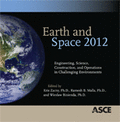Rover Mobility on Granular Soil: Marrying Multi-Scale Modeling and High Fidelity Experiments to Infer Soil Stresses under the Moving Wheel
Publication: Earth and Space 2012: Engineering, Science, Construction, and Operations in Challenging Environments
Abstract
In this work, we show how high resolution imaging coupled with a novel physics-based computational framework can provide a rich description of regolith-structure interactions, using the rover mobility in soft soil as a challenging canonical problem. The images of soil deformation under a rolling wheel were collected at 7 Hz resolution in time and 0.19 mm per pixel in space, with the camera approximately following the wheel motion. The soil under the wheel is a lunar simulant GRC-1. Image correlation (optical flow) was used to infer material velocities, i.e. regolith kinematics, at near-grain scale. From this data, strains can be calculated during post-processing, but stresses are beyond the reach of experimental measurements. Here we present a method to infer material stresses under the rolling wheel using a multiscale framework with a simple Drucker-Prager material description. From a purely computational standpoint, this mobility problem is extremely challenging involving wheel-regolith contact and interacting localization bands on the material scale, as indicated by the experiments. Capturing these features with the correct constitutive description is at the very cutting edge of computational research today. We bypass some of the aforementioned difficulties by inferring from experimental images a key plastic internal variable, the dilatancy, which is known to control strength and softening in dilative granular materials, and use its evolution directly in multi-scale computations. The method successfully marries experiments and computations in order to quantify material stresses under the wheel, which at present are beyond the reach of either method alone. From a practical standpoint, an understanding of the material stress state is helpful for several reasons, perhaps the chief of which is that stress distributions serve as input into reduced-order mobility models, e.g. Bekker-Wong terramechanics expressions.
Get full access to this article
View all available purchase options and get full access to this chapter.
Information & Authors
Information
Published In
Copyright
© 2012 American Society of Civil Engineers.
History
Published online: Jul 11, 2012
Authors
Metrics & Citations
Metrics
Citations
Download citation
If you have the appropriate software installed, you can download article citation data to the citation manager of your choice. Simply select your manager software from the list below and click Download.
